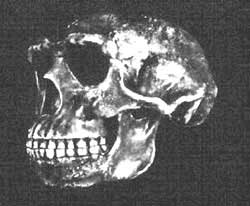No blood relation
 SPECULATION as to whether the modern human race has any blood link with the Neanderthals may now be put to rest. There is none. Possibility of the Neanderthals - people who inhabited Europe more than 28,000 years ago - having mingled with the human race as we know it now through interbreeding have been further negated by the revelations made by latest scientific research.
SPECULATION as to whether the modern human race has any blood link with the Neanderthals may now be put to rest. There is none. Possibility of the Neanderthals - people who inhabited Europe more than 28,000 years ago - having mingled with the human race as we know it now through interbreeding have been further negated by the revelations made by latest scientific research.
New evidence collected by studying the deoxyribonucleic acid (DNA) extracted from the ribs of a Neanderthal infant supports the earlier thesis that this ancient people, known for their hardy, robust bearing, had indeed perished without leaving any genetic legacy in the subsequent human generations. Simply put, the modern human population has no resemblance, physical and otherwise, with the Neanderthal people.
The latest DNA study was conducted by William Goodwin of the Human Identification Centre at the University of Glasgow along with Russian and Swedish colleagues.
Goodwin was given a sample of an infant's ribs discovered in the Mezmaiskaya cave in the Caucasus, northeast of the Black Sea. The remains of the infant - aged less than two months and dated by carbon isotope method to 29,000 years ago - was discovered from the Mezmaiskaya cave by a group of Russian scientists from the Moscow Institute of Archaeology.
This is the second such study conducted on DNA extracted intact from the ancient bones of people who had walked the earth thousands of years ago.
Three years ago, Neanderthal DNA was first isolated from the original bones first found in the Feldhofer cave in the Neander Valley near Duesseldorf in 1856. Scientists were startled to discover DNA that was at least 30,000 years old. Further, the Neanderthal DNA showed a pattern quite different from that found in modern human beings.
In both the instances, scientists were surprised that the DNA could have survived the immense time gap and they feel confident that further research could reveal the genetics of this extinct human race.
A study in June last year had, however, raised speculations that modern humans could be descendants of the Neanderthals through inter-breeding. The study was conducted n the remains of a thick-set boy hose remains were recovered from a cliff-side grave in Portugal. Paleoanthropologists said the boy's stocky features resembled those of the Neanderthals and, therefore, it could be possible that modern humans could have inter-breed with the Neanderthals. This fact has been refuted by Goodwin.
According to Goodwin, the DNA sequence from the Mezmaiskaya cave is 3.5 per cent different from that obtained from the Neanderthal bones of the Feldhofer cave.
This merely suggests a considerable genetic diversity within the Neanderthals. However, Goodwin and his fellow researchers assert, both the Neanderthal DNA samples are very different from those of modern human beings.
Related Content
- Order of the Punjab and Haryana High Court regarding deteriorating medical infrastructure in Punjab, 13/05/2025
- Order of the National Green Tribunal regarding chromium dumps at Rania, Kanpur Dehat, Rakhi Mandi, Kanpur Nagar and Fatehpur, Uttar Pradesh, 07/03/2025
- The Toxic Truth: Children’s Exposure to Lead Pollution Undermines a Generation of Future Potential
- Report on management of bio-medical waste, Uttar Pradesh, 24/07/2020
- 20% heart attack patients in 25-30 age group
- State of Global Air 2018
